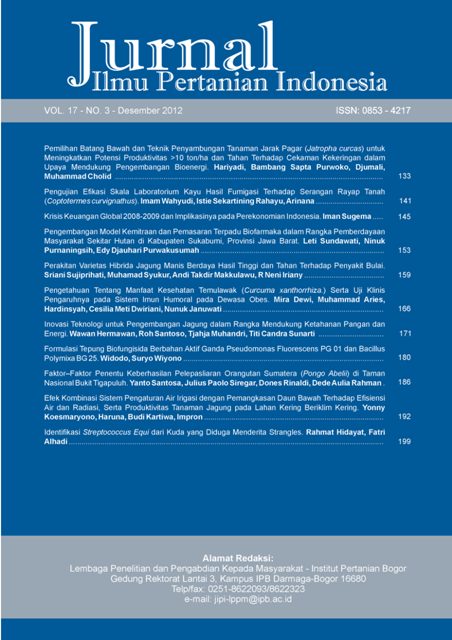Pemilihan Batang Bawah dan Teknik Penyambungan Tanaman Jarak Pagar (Jatropha curcas) untuk Meningkatkan Potensi Produktivitas >10 ton/ha dan Tahan Terhadap Cekaman Kekeringan dalam Upaya Mendukung Pengembangan Bioenergi
Abstract
Development of Jatropha in large scale in dryland requires plant material with high productivity and ability to adapt drought conditions. Attempt to maintain the stability of jatropha production in dry land can be done through grafting technology by combining the advantages of prospective shoot section which has high yield potential as a scion and rootstock candidates from plant material that is able to adapt to limited water availability. Three activities were carried out at the first year experiments including (1) selection method of drought stress that is fast, accurate and simple under laboratory condition, and (2) adaptability study of jatropha rootstock candidates associated with drought stress in glasshouse and in the field. The result showed that the method of drought stress that was fast, accurate and simple under laboratory condition was that using polyethylene glycol. Three jatropha rootstocks, namely IP-3M, Sulawesi 117, dan NTB 047, are tolerant to drought stress associated with drought stress both in glasshouse and in the field condition.
Downloads
References
Ahmad S, Ahmad R, Ashraf MY, Ashraf M, Waraichi EA. 2009. Sunflower (Helianthus annuus L.) respons to drought stress at germination and seedling growth stages. Pak J Bot. 41(2): 647-654.
Ashraf MY, Naqvi MH, Khan AH. 1996. Evaluation of four screening techniques for drought tolerance in wheat (Triticum aestivum L.). Acta Agron Hung. 44: 213-220.
Bates LS, Waldren RP, Teare ID. 1973. Rapid determination of free proline for water-stress studies. Plant Soil. 39: 205–207.
Blum A. 1985. Breeding for crop varieties for stress environments. Crit Rev Plant Sci. 2: 199–238.
Cholid M, Romli M, Estiana H. 2006. Regenerasi tunas jarak pagar (Jatropha curcas L.) melalui micro cutting. Lokakarya II Status Teknologi Tanaman Jarak pagar (Jatropha curcas L). Bogor, 29 Nopember 2006. Puslitbangbun.
Djumali, Kadarsih SA. 2009. Karakteristik batang jarak pagar (Jatropha curcas L.). Prosiding Penelitian dan Pengembangan Perkebunan. Pusat Penelitian dan Pengembangan Pertanian.
Djumali, Machfud M. 2009. Fotosintesis dan kaitanya dengan produksi tanaman jarak pagar (Jatropha curcas L.). Prosiding Lokakarya Nasional IV Jarak Pagar: Akselerasi Inovasi Teknologi Jarak Pagar Menuju Desa Mandiri Energi. Surya Pena Gemilang Publishing. Malang. p. 177-183.
Djumali. 2010. Identifikasi karakter tanaman jarak pagar yang mempengaruhi produksi dan kadar minyak. Laporan Tengah Tahun Balittas. Malang.
Fisher RA, Maurer R. 1978. Drought stress in spring wheat cultivars: 1. Grain yield responses. Aust. J. Agric. Res. 29: 897-912.
Hamdi AH. 2007. Implementasi kebijakan pengembangan jarak pagar sebagai sumber BBN. Prosiding Lokakarya Nasional II Jarak Pagar: Status Teknologi Tanaman Jarak Pagar Jatropha curcas L. Pusat Penelitian dan Pengembangan Perkebunan. Bogor. p. 1-6.
Haryadi SS, Yahya S. 2008. Fisiologi stres tanaman. Bogor (ID): Institut Pertanian Bogor.
Hasnam. 2007. Status perbaikan dan penyediaan bahan tanaman jarak pagar (Jatropha curcas L.). Prosiding Lokakarya II: Status Teknologi Tanaman Jarak Pagar, Jatropha curcas L.
Lapanjang I, Purwoko BS, Hariyadi, Budi RSW, Melati M. 2008. Evaluasi beberapa ekotipe jarak pagar untuk toleransi cekaman kekeringan. Bul Agron. 37(3): 263-269.
Mulyani AF, Agus, Allelorung D. 2006. Potensi sumber daya lahan untuk pengembangan jarak pagar (Jatropha curcas L.) di Indonesia. Jurnal Litbang Pertanian. 23(4): 130-138.
Neumann PM. 2008. Coping mechanisms for crop plants in drought-prone environments. Ann Bot 101(7): 901–907.
Parry MAJ, Flexas J, Medrano H. 2005. Prospects for crop production under drought: research priorities and future directions. Ann Appl Biol. 147: 211–226.
Reynolds MP, Mujeeb-Kazi A, Sawkins M. 2005. Prospects for utilizing plant-adaptive mechanisms to improve wheat and other crops in drought and salinity-prone environments. Ann Appl Biol. 146: 239–259.
Schulze ED, Beck E, Hohenstein KM. 2005. Environment as Stress Factor: Stress Physiology of Plants. Plant Ecology. 702p.
Serraj R, Hash TC, Buhariwalla HK, Bidinger FR, Folkertsma RT, Chandra S, Gaur PM, Kashiwagi J, Nigam SN, Rupakula A, Crouch JH. 2005. Marker-assisted breeding for crop drought tolerance at ICRISAT: achievements and prospects. In: Tuberosa R, Phillips RL, Gale M (eds) Proceedings of the International Congress “In the Wake of the Double Helix: From the Green Revolution to the Gene Revolution”. Avenue Media. Bologna. Italy. pp 217–238.
Sitompul SM, Guritno B. 1995. Analisa Pertumbuhan Tanaman. UGM Gadjah Mada University Press.
Subbarao GV, Ito O, Serraj R, Crouch JJ, Tobita S, Okada K, Hash CT, Ortiz R, Berry WL. 2005. Physiological perspectives on improving crop adaptation to drought justifi cation for a systematic component-based approach. In: Pessarakli M (ed) Handbook of Photosynthesis, 2nd edn. Marcel and Dekker. New York. pp 577–594.
Sudarmo H, Heliyanto B, Suwarso, Sudarmadji. 2007. Aksesi potensial jarak pagar (Jatropha curcas L.). Dalam Prosiding Lokakarya II: Status teknologi tanaman jarak pagar Jatropha curcas L. Pusat Penelitian dan Pengembangan Perkebunan. p. 111-114.
Yoshida S, Forno DA, Cook JH, Gomez KA. 1976. Laboratory Manual for Physiological Studies of Rice. Ed. Ke-3. Philippines: IRRI. 83p.
This journal is published under the terms of the Creative Commons Attribution-NonCommercial 4.0 International License. Authors who publish with this journal agree to the following terms: Authors retain copyright and grant the journal right of first publication with the work simultaneously licensed under a Creative Commons Attribution-NonCommercial 4.0 International License. Attribution — You must give appropriate credit, provide a link to the license, and indicate if changes were made. You may do so in any reasonable manner, but not in any way that suggests the licensor endorses you or your use. NonCommercial — You may not use the material for commercial purposes.



















